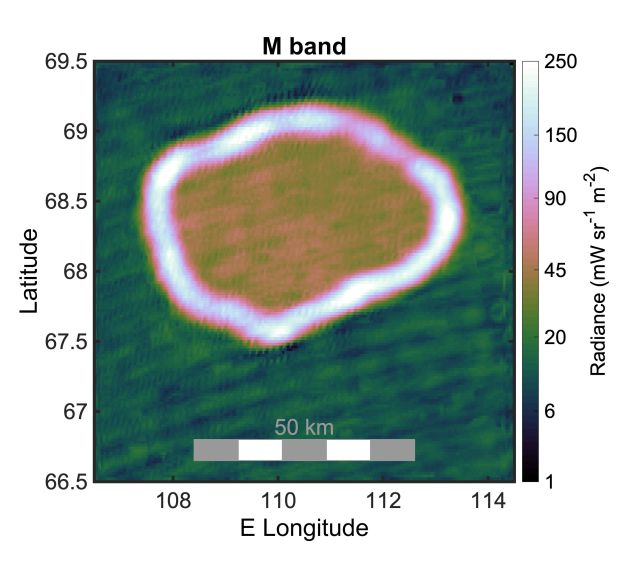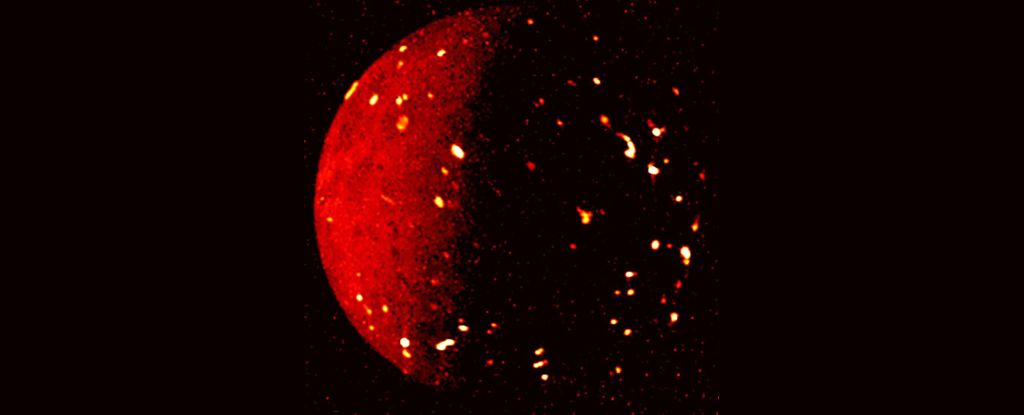Products You May Like
As bristling with volcanoes as a porcupine with quills, Jupiter‘s moon Io is the most volcanically active world in the Solar System. At any given time, around 150 of the 400 or so active volcanoes on Io are erupting. It’s constantly spewing out lava and gas; a veritable factory of volcanic excretions.
And, thanks to the Juno probe’s Jovian Infrared Auroral Mapper (JIRAM) imaging Jupiter and its surrounding environment, we now know a lot more about what a gloriously hot mess Io is.
“The high spatial resolution of JIRAM’s infrared images, combined with the favorable position of Juno during the flybys, revealed that the whole surface of Io is covered by lava lakes contained in caldera-like features,” says astrophysicist Alessandro Mura of the National Institute for Astrophysics in Italy.
“In the region of Io’s surface in which we have the most complete data, we estimate about 3 percent of it is covered by one of these molten lava lakes.”
Io is the victim of a complex game of gravitational tug-of-war. Its orbit around Jupiter isn’t perfectly circular, which means the attraction between moon and planet changes in intensity over time. In addition, the other Galilean moons of Jupiter – Callisto, Europa, and Ganymede – have enough mass to exert a gravitational influence of their own on Io.
The upshot of all this conflicting gravitational influence is stress on the interior of Io, generating heat that gushes out in the form of volcanism. The little moon is one hot potato.

While we have a pretty good understanding of the dynamics that are squeezing and stretching the innards of Io, and the effect all this has on the broader environment around Jupiter and the giant gas planet itself, there’s a lot we don’t know about how the volcanism manifests on the surface of Io.
That, luckily, fell under Juno’s remit. As the probe explores Jovian space, it’s conducting flybys of some of the moons, using its instruments to collect data closer up and more personally than we’ve ever reached before. Recently, the probe conducted a series of very close flybys of Io, revealing the sulfurous moon in amazing detail.
We’ve seen the plumes of actual volcanic eruptions, and lakes of lava shimmering on the surface. Now, scientists have analyzed some of that data, in particular the infrared observations captured by JIRAM, which reveals heat signatures on the surface of Io.
From this, scientists were able to observe lava lakes that consist of a ring of exposed liquid lava lapping at the edges, with a hardening crust in the center of the molten lake, and forming the high lake walls around the bowl-shaped patera in which the lava collects. This finally reveals the most dominant form of volcanism on Io.
frameborder=”0″ allow=”accelerometer; autoplay; clipboard-write; encrypted-media; gyroscope; picture-in-picture; web-share” referrerpolicy=”strict-origin-when-cross-origin” allowfullscreen>
“We now have an idea of what is the most frequent type of volcanism on Io: enormous lakes of lava where magma goes up and down,” Mura says.
“The lava crust is forced to break against the walls of the lake, forming the typical lava ring seen in Hawaiian lava lakes. The walls are likely hundreds of meters high, which explains why magma is generally not observed spilling out of the paterae and moving across the moon’s surface.”
This suggests that the lava enters the patera from a magma reservoir below the surface and drains out the same way, causing the lakes to rise and fall. The central crust rubs against the sides of the lake as it moves up and down, breaking the edges off and resulting in a ring of lava around the perimeter of the lake.
The other possibility is that the edges of the crust become weighed down and sink under the lava, once again resulting in a ring.
“The observations show fascinating new information on Io’s volcanic processes,” says Juno principal investigator Scott Bolton of the Southwest Research Institute in the US.
“Combining these new results with Juno’s longer-term campaign to monitor and map the volcanoes on Io’s never-before-seen north and south poles, JIRAM is turning out to be one of the most valuable tools to learn how this tortured world works.”
The research has been published in Nature Communications.
